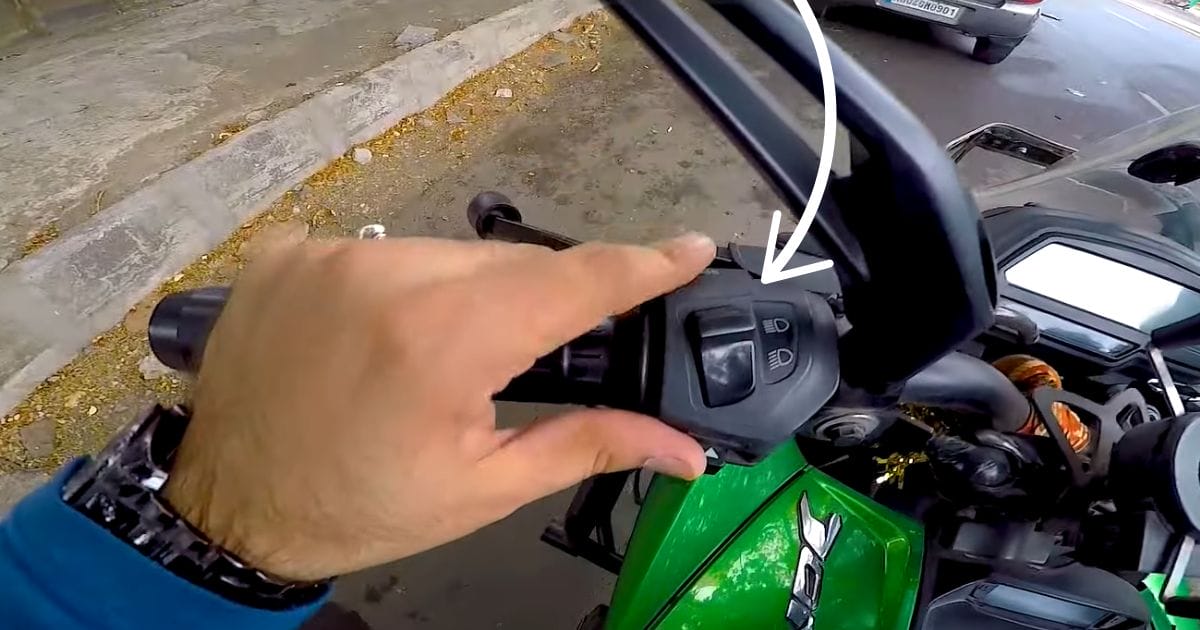What Is The Pass Button On A Motorcycle?
Many riders overlook some useful features on their bikes. One of these is the pass button, but what is the pass button on a motorcycle? It’s a small but important tool that allows riders to flash their high beams quickly. This feature plays a key role in enhancing safety in various situations.
Riders commonly use the pass button when overtaking or riding in low-visibility conditions. It briefly activates the high beam to signal other drivers, improving road awareness and communication.
In this article, you’ll learn when and how to use the pass button effectively. You’ll also discover how it helps keep both riders and other road users safe.
So, Let’s get started!
What is the Pass Button on a motorcycle?
Knowing about the pass button on a motorcycle is essential for safety. It helps communicate your intentions to other drivers. By understanding its function it can enhance a rider’s overall experience.
So, What is the pass button on a motorcycle?

The pass button on a motorcycle is a control that momentarily activates the high beam headlights. Riders often use it to indicate overtaking intentions. It also helps in drawing attention in low-visibility situations. The location of this button is positioned nearly the same but has different colors in different models.
Location on the motorcycle based on different models
You’ll usually find it on the left handlebar. For example, on Kawasaki bikes, it’s positioned above the low/high beam switch. Suzuki models often have it similarly placed but may vary slightly in design. On Triumph motorcycles, it’s typically a small red button located near the turn signal controls.
Basic function:
- Flashes high beam lights to signal other drivers.
- Alerts vehicles that you intend to pass.
- Enhances visibility in low-light conditions.
How to Use the Pass Button on a motorcycle?
It’s important to know how to use the pass button correctly. Every rider should understand the proper way to use it as much as possible.
So, how do you do that? Let’s go through it step by step.
Step-by-step guide on when and how to properly use the pass button.
As a conscious rider, it is important to know when, where, and how to use the press button correctly. Being aware of these rules will help you avoid unnecessary harassment through traffic fines. Additionally, it will ensure the safety of both you and your loved ones.
Here’s the step from where to start:
Step 01: Identify the Situation
Look for a safe opportunity to pass another vehicle. Ensure the road ahead is clear.
Step 02: Activate the Pass Button
Quickly press the pass button to flash your high beams. This alerts the driver in front of you.
Step 03: Check Mirrors
Always check your mirrors for approaching vehicles before moving.
Step 04:Signal Your Intentions
Use your turn signals to indicate you are changing lanes or passing.
Step 05: Proceed with Caution
Once you’ve signaled and the driver acknowledges, safely overtake the vehicle.
You have learned the steps of how to press the button, right? But now the question is, in which exact situations is it necessary to do so?
If we don’t understand the situations, knowing these steps becomes ineffective, doesn’t it?
So, let’s check out those situations.
Situations when you should press the pass button
- Overtaking another vehicle: Use the pass button to signal your intention to pass safely.
- Approaching a blind curve: Flash the high beam to alert oncoming traffic of your presence.
- Warning of hazards: Use the pass button to alert others to potential dangers, like animals or road obstacles.
- Alerting distracted drivers: If a driver seems unaware of you, flash the high beam to grab their attention.
Proper Etiquette When Using the Pass Button
- Use it sparingly: Flash your high beams only when necessary to avoid confusing or irritating other drivers.
- Signal intention clearly: Use the pass button ahead of time to indicate your intent to overtake. Now, try to give the vehicle in front enough time to react.
- Do not blind other drivers: Be cautious when using the pass button at night or in low-light conditions to avoid blinding oncoming traffic.
Does Every Motorcycle Have a Pass Button?
Not every motorcycle has a pass button, but many do. Nowadays, every motorcycle company is using these features to maintain safety.
Previously, the press button was not found. Several classic motorcycles including Vintage models from the 1950s, 1960s, and 1970s often relied on hand signals or other basic signaling methods.
But Now, this feature is common in various motorcycle models, especially in Europe and some sport bikes.
Let’s start with the most common and popular bike examples:
Models with a Pass Button
- Honda: Many models like the CBR series and Africa Twin have a pass button located on the left handlebar.
- Yamaha: Popular bikes like the Yamaha R1 and MT-09 include a pass button, typically placed near the headlight control switch.
- Kawasaki: High-performance models such as the Ninja series often feature a pass button near the horn or light controls.
I understand that older models didn’t have this safety button. So, do all current bike models have it now?
The answer is no. Even today, some bike models still don’t include this feature.
Interested? Want to know?
Let’s give you examples:
- Cruiser and custom bikes, like certain Harley-Davidson models, often lack this feature
But, Why?
Reasons-
- Focusing more on simplified controls.
- Some manufacturers may focus on mechanical simplicity.
Benefits of the Pass Button
Previously, we talked about which motorcycles have the pass button and which don’t.
Now, it’s time to understand the benefits of the pass button, which can make your rides safer and smoother. If your bike has one, you should use it effectively, and if it doesn’t, you might consider adding this feature.

Let’s see 5 and most necessary benefits that you should know:
Improves overtaking safety:
Let drivers know you plan to overtake. Overtaking can be dangerous without proper communication. The pass button quickly signals your intention to pass, giving the driver ahead time to react safely.
Increases visibility in low light:
Makes you more noticeable instantly. In fog, dusk, or poor lighting, your motorcycle might be hard to see. A quick flash of the high beam ensures that others notice your presence right away.
Enhances safety in blind spots:
Alerts drivers who may not see you. Drivers often fail to notice motorcycles in their blind spots. The pass button flashes a quick signal, increasing your visibility where you are least expected.
Prevents accidents effectively:
Warns vehicles and pedestrians immediately. A sudden pedestrian crossing or a car pulling out can lead to accidents. The pass button helps you signal danger, reducing the likelihood of collisions.
Useful in emergencies:
Gains attention when needed urgently. Whether avoiding an obstacle or warning others, the pass button can quickly draw attention to your presence during urgent situations.
Differences Between Pass Button and Headlight Switch
Many people confuse the pass button and headlight switch.
The most probable reason: Both are located on the left handlebar of motorcycles.

Since they are located close to each other on the handlebar, it’s easy to assume they perform the same task. However, their purposes and usage are distinct.
Well! Let’s see their definition in one place and it could be easy to compare:
“The headlight switch allows the rider to toggle between the low beam and high beam for constant use, depending on visibility needs.”
“The pass button momentarily flashes the high beam lights to signal other road users. It is used mainly for overtaking or alerting others to your presence.”
Now, Let’s checkout other core differences:
| Features | Pass Button | Headlight Switch |
| Location | Left handle bar, near index finger. | Left handle bar, near the throttle |
| Control Duration | Temporary | Continuous until switched off |
| Usage | For signaling or overtaking | For night driving |
| Impact on visibility | Instant and brief | Constant lightning adjustments |
Legal and Safety Considerations
As a rider, knowing legal and safety considerations is crucial. Laws vary by region, and understanding them can prevent fines.
Additionally, safety guidelines help ensure your well-being on the road. After discussing models with pass buttons, let’s delve into these important aspects.
Legal Requirements for Pass Button Usage
In some regions, there are specific legal guidelines for how and when to use the pass button. For example:
- In Europe, pass button usage is often regulated, particularly when overtaking.
- Some Asian countries emphasize its use for signaling in crowded traffic.
- In North America, it is less regulated, but its improper use can still be considered aggressive driving.
Common Legal Penalties for Not Complying with Pass Button Regulations(H3)
- Riders may face monetary fines for improper use.
- Non-compliance can lead to traffic tickets.
- Violations might result in demerit points.
- Fines can lead to higher premiums.
- Serious violations may require court attendance.
Safety guidelines for responsible use
Who wants to get involved in police troubles? I can confidently say that you definitely don’t want to encounter such issues.
So, what’s the way out? The answer lies in adhering to the best practices. Below are the guidelines that I believe you should follow:
- Use the pass button sparingly: Overuse can confuse other drivers.
- Avoid flashing in high traffic: Too much flashing can distract drivers.
- Only use it when necessary: Limit to overtaking and visibility situations.
- Do not use at night excessively: Avoid blinding oncoming traffic.
- Signal intention early: Flash ahead of time before overtaking.
Frequently Asked Questions
How does the pass button function differ across various motorcycle brands?
The pass button operates similarly across brands, but its placement and feel differ slightly. Honda places it near the high-beam switch, while Yamaha positions it closer to the turn signal. European brands often integrate it with other systems for enhanced safety, especially on high-end models.
How do I properly use the pass button while overtaking?
To use the pass button when overtaking, press it briefly to flash your high beam, signaling the vehicle ahead. Ensure it’s safe to overtake first, and hold the button longer if necessary in low visibility or heavy traffic, then proceed cautiously.
Can the pass button be customized or programmed for different functions?
Yes, on some motorcycles, the pass button can be customized. It may be programmed to control other functions, such as activating fog lights or additional electronics, depending on the bike’s design. This customization is more common on high-end or touring motorcycles.
Final Word
The pass button on a motorcycle may seem like a small feature, but it plays a big role in rider safety. By knowing when and how to use it, you can communicate effectively with other drivers, making your rides safer and smoother. Whether overtaking, navigating low-visibility conditions, or alerting others to danger, this tool is essential.
Using it wisely not only keeps you safe but also enhances road safety for everyone. Understanding and mastering this feature can significantly improve your riding experience.
And that wraps up this content! If you have any questions, feel free to drop us an email. Thanks for sticking with us!







